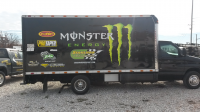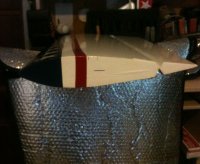You are using an out of date browser. It may not display this or other websites correctly.
You should upgrade or use an alternative browser.
You should upgrade or use an alternative browser.
YellowJacketsRC
70cc twin V2
It's unfortunate that you can't get one of the best IMAC planes anymore. TOC was pretty much monopolized by the 40% Godfrey Extra 300, and Mark Leseberg Jr (pilot) and Tony Russo (builder and caller), along with Andrew Jesky, flew them in IMAC for years. Godfrey never "sponsored" pilots so they had to buy the kits, which says a lot about them. My son flew one in the FL youthmasters to a second place finish four months after he soloed at our club, at 12 years old. Of course Tony went on to run Dalton and ML has the 300ML, so I'll bet it flies as close to the Godfrey 300 Extra as a plane could get. I never flew one, so I don't know.
If you have not flown one of these planes, and have only flown ARFs through the years, you will be nothing short of amazed how tight they fly. IMO, most guys that try to fly IMAC with ARFs lose interest a lot faster than if they flew a well built, well set up, Carden, Dalton, or Godfrey. I've been told that the EF 125 Extra 300 is about as close as you can get with a ARF and the new ones come in the new color scheme too. I'd probably not go bigger than a 104 Extra again, but never say never.
What is it that the ARFs can not match? I mean, the ARFs seem to be built extremely well these days. I have never seen one of these things so I don't know....
dth7
3DRCF Regional Ambassador
What is it that the ARFs can not match? I mean, the ARFs seem to be built extremely well these days. I have never seen one of these things so I don't know....
More "refined" detailing and finishing, more composite and of course more $. Think turbine airframes. Real nice machines but you definitely pay for it.
Decal Dennis
TEAM EP&G
Aeroplayin
70cc twin V2
What is it that the ARFs can not match? I mean, the ARFs seem to be built extremely well these days. I have never seen one of these things so I don't know....
First comes the mindset. US kit designers took this very seriously because of the competition and money. The actual design of the wing was a long R&D process and to this day, ripping off someone else wing makes you a scumbag. I've been to events where planes are housed overnight in a barn/hangar and next thing you know, guys are in there with tape measures trying to figure our why one plane seemed to have an advantage over the other. The Chinese look at this more as a plane to fly and crash and buy another one, and price it so that this is not too painful. When guys crashed a kit, they repaired it quickly, and it flew again. When a guy flew it nose first into the ground and lost a kit-built, they cried for a long time and many never recovered, or could manage the cost of replacement.
Most of the good kits then and today are sheeted foam for light strength and rigidity. It's the same composite engineering used in full scale, but with different material, and at least the kit designer that I knew personally, understood engineering principles. Any designer or builder that does not know the basics of Young's modulus principles of stress and strain, IMO, is really nothing more than a furniture builder that likes airplanes. Nothing against furniture builds, of course.
I've seen kits flying in IMAC competition that are 15 years old and look brand new, and still fly as tight as the day they were built. Epoxy and aliphatic resins were used, thicker Monokote, stringers were 10mm and ply was 3mm and 6mm three-ply to keep it strong and light. I had eleven flat nylon Dubro hinges in each wing on my 35% and each hinge was pinned with four wood dowel or the shaft of round wood toothpicks. I never used a drop of thin CA in any of the builds I was involved in, and used medium CA only for pinning hinges.
All this strength, and my 35% with a 103 inch wing, came in at 21 pounds all-up with a full tank of fuel. Proper materials selection, and attention to design and engineering principles, is how you do this. Every angle is straight, except those not intended to be (and there are a few of these). If you never spent a winter putting a top quality kit together, patiently, rolled it out in the spring, and did a slow roll over the runway using only aileron with no programming on the maiden flight, you should add it to your bucket list.
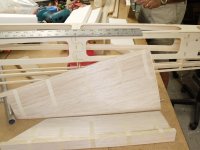
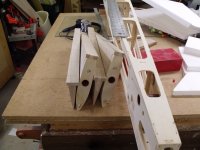
Last edited by a moderator:
AKfreak
150cc
If you never spent a winter putting a top quality kit together, patiently, rolled it out in the spring, and did a slow roll over the runway using only aileron with no programming on the maiden flight, you should add it to your bucket list.
That's what I'm talking about. I want to own a plane like this. I want one that flys extremely well without fighting it. I know these planes do exist, however I am a very long way away from owning one. My extra 260 is sheeted foam, it's light and to me it's beautiful. It however has these thick wings and minimal throws. I want to give this plane new life. I want to find some wings that are the latest design like the Carden thin wings. I want my plane to slow down and not drop a tip like my EF planes do, and I want it to fly precise and effortlessly like you describe so wonderfully in the above quote.
I have a long road ahead, but when I am finished, I can be proud of that I have. My extra 260 had a lot, going for it. The weight is one thing. It's super light for its size. Also, it had thick aluminum gear, and wing tube. This will be replaced with CF making it even lighter. I love the split cowl, and the lines on this plane, to me, are outstanding. It's a diamond in the rough, one that will get some love soon.
Aeroplayin
70cc twin V2
I want my plane to slow down and not drop a tip like my EF planes do, and I want it to fly precise and effortlessly like you describe...
You may find that thicker wings -- thickness from bottom to top at the spar line -- will experience separation later as you increase the angle of attack. Since wing rock is all about one wing continuing to "fly" while the other experiences a degree of separation, and the drag that goes along with the vortex associated with it, the question is this... does sooner separation solve this or not?
The facts are that thicker wings are used more when you want less separation when entering up-line maneuvers so that there is even lift and little drag, which will happen sooner on thinner wings. Thicker wings will also slow the down-line, and on a symmetrical wing, any AoA variation from the perfect 180 degrees the down-line will not create as much separation and drag, which will perpetuate the unwanted variation to the down-line 180 degrees angle.
Maybe someone can comment on this that has the airplane already, but it looks like the new 74 Laser EXP has a thicker wing than the 78 Extra. I know I'm a little overboard with this stuff, but here's a profile comparison between my 85 inch Godfrey wing profile, and the AJ Laser Z wing profile, and then the 78 wing...
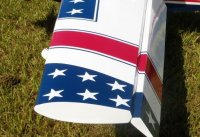
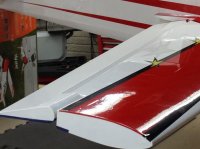
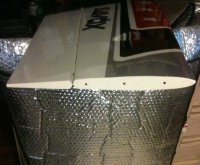
Aeroplayin
70cc twin V2
YellowJacketsRC
70cc twin V2
Interesting to see how thick the AJ Laser wing is.....
So how does a plane like this perform a slow roll without any input other than aileron? What keeps the nose up as you roll to KE?
So how does a plane like this perform a slow roll without any input other than aileron? What keeps the nose up as you roll to KE?

